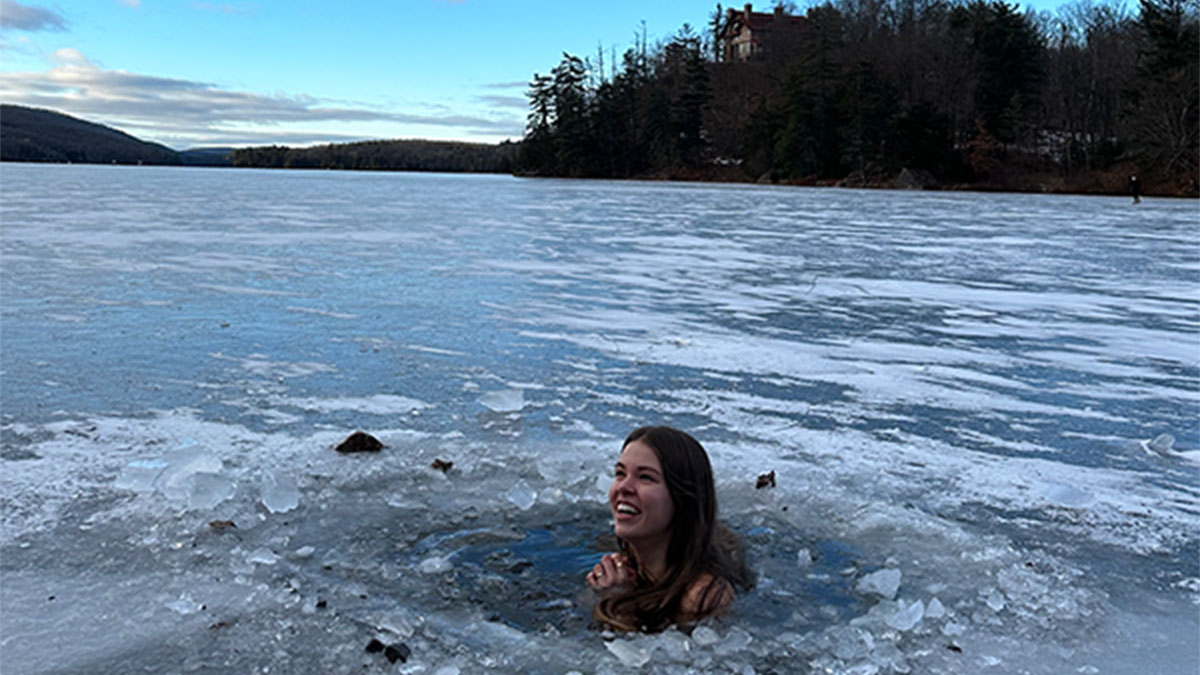On New Year’s Day, while many people were at home nursing hangovers, Katie Potter welcomed 2024 with a plunge into ice-cold water.
“I think it’s a good way set intention for the New Year and show that you can do hard things for the benefit of yourself,” said Potter.
“I made a challenge for myself to go once a month for a year,” Potter said, after having started this past October. “So far, January was the hardest!”
Potter added that she found the dips gave her some welcome respite from the stress of her life.

“I’m a recent graduate from university entering the workforce and I find working can be really stressful and cold plunging is a really good way to distract yourself,” Potter said. “All you can think about is how cold you are.”
Benefits and risks
Research on the benefits of cold exposure tends to be limited partly because of all the variables including how long people are exposed to cold and hot cold it is along with other factors.
While many people — including fitness influencers — claim they get a lot of benefits from the plunge, and some studies have suggested that plunging regulates could be helpful in treating type 2 diabetes and inflammation, scientists warn there is very little hard evidence about the benefits.
François Haman has been studying ‘cold’ for the last 24 years. Haman is a professor in the Faculty of Health Sciences at the University of Ottawa and specializes in the effects of cold on energy, metabolism and physiology. Most recently, Haman has been working with the Canadian military training soldiers to overcome cold shock.
Haman says there can be benefits and risks to cold plunging. On the benefit side is that cold exposure is a natural stimulant.
“There’s a dopamine release so you feel good during it and even after being in cold, you get that stimulation,” said Haman.
When it comes to the supposed boost for your immune system however, Haman insists that there is no scientific proof that cold water immersion benefits your immune system. In fact the hypothermic nature of the cold plunge can actually reduce your immune response.
Haman also explains that while there is an element of meditation in a cold plunge through calming your breathing and slowing your heart rate under stressful conditions, this can in fact be an added danger.
“As you get very good at doing it and tolerating that pain you always push the envelope,” Haman said. “You kind of forget that your body is cooling down non-stop and you’re becoming more and more hypothermic.”
“Ice water plunge is literally like being hit by lightning,” Haman added.
Hitting icy water creates such an intense response within the body that your blood pressure increases exponentially and you can even go into cardiac arrest, regardless of age and overall health, Haman warned.
Rising popularity
Despite these dangers, regular cold plunging has grown in popularity over the last few years, particularly throughout the pandemic. The #coldplunging has more than 1,000 posts on Instagram with popular videos of influencers taking the plunge or advertisements for at home tanks gaining more than 60,000 views each.
The Royal Canadian Geographical Society has hosted an annual Polar Plunge for the past three years to raise funds for their Canadian Geographic Explore podcast. This year they have already surpassed their fundraising goal for the March 2 plunge with more than $30,000 raised so far.
David McGuffin, host of the Canadian Geographic Explore podcast, says he has developed a strong affinity for taking the plunge.
“Coming out of that water it’s just amazing how charged your body feels,” said McGuffin. “Every cell is just humming, it really sticks with you throughout your day.”
McGuffin says he has seen a rise in popularity for the plunge as people are lining up to take part in the event and he has already had more inquiries from willing participants this year than ever before.
“Last year we had 12 places across the country including the Arctic. People in Nunavut did the plunge along with us here in the Gatineau hills,” McGuffin said.
Potter has also found more and more people are reaching out to her, eager to join in on the plunge after she posted a video on social media.
“I didn’t think anyone was gonna join but people watched my TikTok and now I have a group that I go with every month cause they saw it and were like ‘this looks sick’,” Potter said.
As the popularity has risen so do the risks, as many people are unaware of the proper precautions to take while plunging.
Haman says he is “shocked” by the negligence he sees at community plunging sites. He strongly suggests that those who are cold plunging try and stick to a maximum of two or three minutes in the water.
“We know that within this limit you will not become hypothermic and you’ve still got all the benefits of dealing with that cold shock,” Haman said.
He also urges people who are plunging on a regular basis to wear protection on their hands and feet in order to avoid hypothermic damage to the extremities and ensure a safe plunge.




